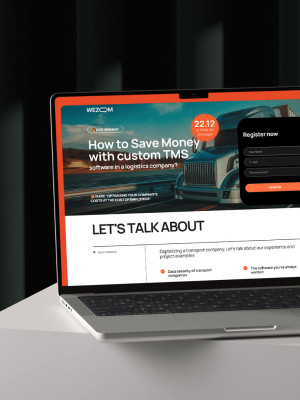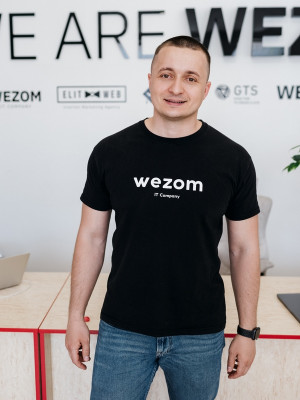What Are The Logistics Apps?
No matter what type of business you own, there are always logistics processes involved. Whether it is a small B2C business with a few retail locations or a large enterprise managing complex networks of operations, the goal is the same - deliver the product to the customer in a timely and most convenient way. The goal is not simple, considering logistics costs take around 10% of each sale you make.
Out of this amount, 53% of the value goes towards the last mile delivery. Now, let's look at the differences between companies that make less than $100 million and companies that make more than $2 billion in annual sales. We notice that the latter spends three times less on logistics expenses as a percentage of yearly sales.
The secret is the tools that manage the logistics flow within the organization, and the larger your business is, the more unique and refined the set of tools becomes.
The market is full of software dedicated to optimizing supply chain operations for any business. The list of purposes is limitless, considering the area of application. Inventory, yard, or warehousing management systems focus on boosting logistics operations associated with the coordination of goods on-premise. Anything that goes beyond is captured by transportation management software or digital systems concentrating on capturing and optimizing vehicles' data, managing and organizing loads during transportation between locations, and streamlining communication between the parties involved.
There are also applications with a narrower focus, such as demand planning, packaging, shipment tracking, fuel management, courier management, parking management, dock scheduling, or barcoding software. Each of these has a specific function with a wide range of tracking and automation capabilities explicitly created to manage operations associated with them.
Roles and Features
Despite the versatility of the tasks performed by the logistics software, the roles are mostly structured in the following manner:
- User - depending on the application, a user is a party that receives the services or goods from the business. Users are often provided with the registration and profile creation capabilities. Users can choose and change a service they want to use, input and manipulate delivery information, reserve orders or vehicles, see and compare rates, see order details, driver information, and receive notifications. A user should also have the ability to communicate to the company or the parties involved.
- Driver - drivers are people physically delivering orders to the destination. Drivers could be contractors, half-time, or full-time employees. Just like users, they can create and manipulate their profiles. They can also show their availability to complete orders, pick up orders, or be assigned deliveries by the management; drivers can upload documents, see and receive the payments, and communicate with the appropriate parties.
- Dispatcher/Admin/Manager - Depending on the permissions, this role manages users and drivers within the application. They take care of uploading orders and reassigning them, managing billing data, changing subscription plans (if any), and reassigning sub-manager roles.
- Superadmin - superadmins have the maximum power and authority within the application. It is a top role that can change any other role's permissions and company's profile information.
In a typical transportation management system (TMS), a dispatcher or administrator inputs the order information into the system. The fields that contain the information include shipping and destination addresses, order/load ID, contact information, rates/quotes, shipper/customer information, comments, and the appropriate attachments. If any integration persists, this data could be automatically imported from the web application for which most of it is entered directly by the customer.
How the dispatcher-driver communication is done depends on the business model of the company. Once the order is filled, it could either be manually assigned to a specific driver, or the administrator could upload it to the general dashboard, where drivers can reserve the orders they want to complete depending on the availability.
Once the order is reserved, the BOL is signed, both shipper and managers get notified, etand the order enters the "in progress" stage.
From now on, the shipper receives notifications and updates regarding the delivery. If the driver has to pass the order to another carrier, the action is recorded using either signatures or photo-fixation depending on the needs. All the records are kept on the database and are available for admins and superadmins for reports and manipulation. Once the load reaches its final destination and the parties verify the delivery, the order becomes "completed." The order binds to the drivers' profiles, and they can receive the paystub.
Technology Stack
Technology Stack is a combination of technologies that will be used to create and maintain your software. Choosing the best set of instruments to define the most optimal foundation for your software requires deep understanding of your business processes, its target audience, and the operations that need to be automated and tracked.
If you are building a custom logistics software for your business, the technology stack you choose initially will define the future scalability, the cost of expansion, the difficulty of integration with other applications, and the future of your business in general. The technologies you choose will be used for both front-end and back-end application development.
The front-end is a client-oriented part of the application which is a mix of HTMS, CSS, and JavaScript.
These languages in combination with frameworks such as, for instance, React, Angular, Vue.js, jQuery or any other framework will be used to build all the visual elements of the application. The back-end parts consist of the server, database, and the communication between the layers. The server-side development concompasses all of the components needed to run an application.
The most famous programming languages used for this type of development are PHP, Python, C#, C++, Java, JavaScript.
Similar to front-end mechanics, the framoks for back-end development are the environments where programming languages are used to write the infrastructure for the application. It's Django, Flask, Hug, Bottle, or CherryPy or Python; Laravel, CakePHP, CodeIgniter, or Symfony for PHP; .NET for C#; Spring, Struts, or Hibernate for Java.
The framework choice depends on the application type and specific functionality features that it needs to have. For mobile app development software, the list of programming languages and frameworks depends on the platform. iOS applications are built using Swift or Objective-C programming; for Android it’s Kotlin or Java programming languages.
Any application must have a set of algorithms that define where and how the data must be stored and retrieved from a database. There are relational and nonrelational databases. A relational database contains items with predefined relationships between them and uses Structured Query Language (SQL); the latter uses other model types for the data management.
For example, Oracle, PostgreSQL, MySQL are relational while MangoDB, Redis, or Apache Cassandra are non-relational. If you're working with complicated queries and the application will have a high volume of transactions, SQL database would be the right choice. The back-end frameworks like Laravel or Flask are used to write communication rules between client-side parts and databases.

When a user requests any data from the database, any web application must communicate to the server for these requests. There are open-source application servers such as Apache or Nginx that deal with static and dynamic content on the web.
Once the infrastructure is ready, you need to host it somewhere. Cloud is the most used option for running any web-based applications. Google Cloud or Amazon Web Services are popular for such tasks.
Whenever you deal with complex APIs, you need a framework that efficiently manages data requests from multiple data sources. GraphQL or REST API will come in handy to provide developers with convenience when dealing with data across both front-end and back-end sides. There are also additional frameworks for dealing with payments, language or image processing, and various integrations that will be happening in the future.
If you deal with an experienced team of developers, they will provide you with options and explain why a certain technology should be implemented as well as explain the benefits of choosing one over another.
How Much Does It Cost to Develop a Logistics App?
The final price to develop a logistics application will depend on a variety of factors. Most of the time, the prices get updated during the initial rounds of communication with the developers. If a client has its CTO with a list of technologies, technical assignments, and a prototype, then the developers' team estimates the size of the team and the number of hours that specialists will spend to complete the work.
In the situation where a client doesn't have a fully developed idea, the development company invites the client to the Discovery Stage where a business analyst, project manager, and tech architect meet with the client and the stakeholders. They analyze the business idea, goals, target audience, the market, and, in case of the logistics companies, how the application will optimize the company's logistics performance.
Then, the platforms for which the application must be built are chosen. Lastly, a tech architect and the engineers propose a list of application tech for the development. After the discovery stage, which usually lasts around 1-2 months depending on the project complexity, the client gets a full roadmap with all the functionalities of the future application with a prototype. At this point, the client knows how long and what people will be working on the applications with a list of hourly rates for each specialist.




